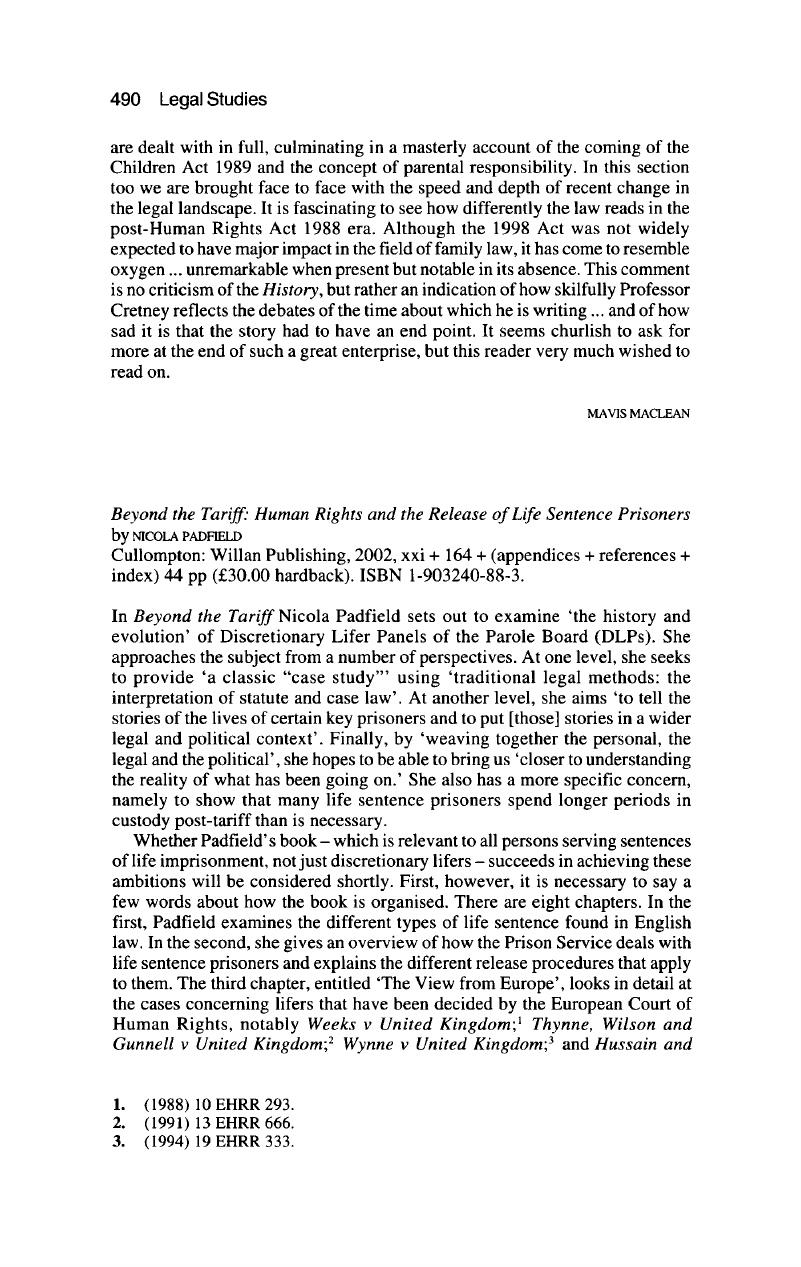No CrossRef data available.
Article contents
Beyond the Tariff: Human Rights and the Release of Life Sentence Prisoners by Nicola Padfield, Cullompton: Willan Publishing, 2002 xxi + 164 (appendices + references + index) 44 pp (£30.00 hardback). ISBN 1-903240-88-3.
Published online by Cambridge University Press: 02 January 2018
Abstract

- Type
- Book Review
- Information
- Copyright
- Copyright © Society of Legal Scholars 2004
References
1. (1988) 10 EHRR 293.
2. (1991) 13 EHRR 666.
3. (1994) 19 EHRR 333.
4. (1996) 22 EHRR 1.
5. In particular, the Criminal Justice Act 1991; the Parole Board Rules of 1992 and 1997; ss 28–32 of the Crime (Sentences) Act 1997, which extended DLP procedures to juveniles sentenced to be detained during Her Majesty's Pleasure for the crime of murder; and s 60 of the Criminal Justice and Courts Services Act 2000, which (by inserting a new s 82A into the Powers of Criminal Courts (Sentencing) Act 2000) removed the Home Secretary's power to set a ‘tariff’ in HMP cases.
6. An Exploration of Decision-making at Discretionary Lifer Panels Home Office Research Study No 113 (London: Home Office, 2000).
7. The book also sometimes presents information in a way that might mislead the unwary reader. An example is where the author observes that ‘eleven released discretionary life sentence prisoners were recalled to prison in 1998–9, nine each in 1999–2000 and 2000–1, compared with only four in 1993’. In order for anything meaningful to be concluded from these figures, they need to be set against the number of discretionary lifers living in the community under the supervision of the probation service at the time when the recalls were made.
8. (2002) 35 EHRR 32. The case is discussed in the preface to Padfield s book, at pp xi–xii.
9. [2002] UKHL 46, [2002] 4 All ER 1089.
10. Quoted in the preface, at p xii.
11. Under s 269(2), the sentencing judge will have to specify the minimum period of time that a prisoner must serve before the Parole Board can consider release on life licence. Under sub-s (3), when making his decision on the minimum term, the judge must take into account both ‘the seriousness of the offence, or the combination of the offence and any one or more offences associated with it’ and any time spent on remand. Under sub-s (4), if the offender was aged 21 or over when the offence was committed and the judge takes the view that the murder was particularly grave, he may make an order that ‘the early release provisions are not to apply to the offender’, described in para 1 of Sch 21 as a ‘whole life order’. S 270 requires the judge to state, ‘in ordinary language, [his] reasons for deciding on the order made’, and in stating these reasons he must, ‘in particular - (a) state which of the starting points in Schedule 21 [he] has chosen and [his] reasons for doing so, and (b) state [his] reasons for any departure from that starting point’. Finally, s 275 provides that, once the minimum term has expired, a mandatory lifer will be able to require the Home Secretary to refer his case to the Parole Board so that it can consider his suitability for release.
12. Under s 269(5) of the Act a sentencing judge, when considering the seriousness of a murder, is mandated to ‘have regard to the general principles set out in Schedule 21’. The judge is also instructed to have regard to ‘any guidelines relating to offences in general which are relevant to the case and are not incompatible with the provisions of Schedule 21’.
13. See para 5(1).
14. See para 6.
15. See para 7. The lower starting point for juveniles was introduced late in the day (see 1978 HC Official Report (6th series) col 737ff, 18 November 2003) after the House of Lords had voted to remove juveniles from the framework entirely. Para 12 explains that nothing in the Schedule restricts the application of those sections of the Act which affect the sentencing of offenders who have committed offences while on bail (see s 143(3)), have previous convictions (see s 143(2)) or have entered a guilty plea (see s 144). Once a starting point has been selected, para 8 requires the sentencing judge to ‘take into account any aggravating or mitigating factors, to the extent that [he] has not allowed for them in [his] choice of starting point’. Para9informs the judge that ‘detailed consideration’ of these factors (listed in paras 10 and 11) ‘may result in a minimum term of any length (whatever the starting point), or in the making of a whole life order’. Nonetheless, the Explanatory Notes to the Act (see para 835) make it clear that the intention is that, while ‘there may be a few very exceptional cases in which starting points will be increased or decreased very substantially’, ‘the vast majority of cases will tend to attract minimum terms that reflect the categorisation of cases set out in paras 4 to 7’.
16. See 649 HL Official Report (5th series) col 598, 16 June 2003. See also the Lord Chief Justice's memorandum on mandatory life sentences for murder which was deposited in the House of Lords Library by Lord Woolf on 16 June 2003: ‘Sentencing, particularly in relation to murder, should be removed from the political arena. The present proposal will have the effect of increasing political involvement.’
17. See s 336(2) of the 2003 Act and Home Office Circular 62/2003.


